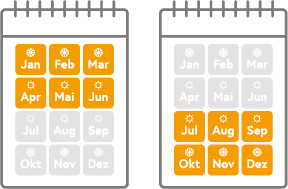Reference values - radon risk limitation
According to the EU's Basic Radiation Protection Standards Directive 2013/59/Euratom (→ EUR-Lex), a reference value of 300 Bq/m³ must not be exceeded in workplaces. However, the reference value of 300 Bq/m³ should also not be exceeded in private households, if possible.
It is recommended that ...
- from a mean radon concentration of 300 Bq/m³, remediation measures should be carried out in existing buildings.
- in new buildings, the average radon concentration should be significantly below 300 Bq/m³.
It is estimated that about 10 percent of all households in Austria have radon concentrations above 300 Bq/m³.
Variations of radon concentration in residential buildings
The radon concentration in a building depends primarily on the building fabric (tightness in the foundation area or walls in contact with the ground). Furthermore, the construction method and the behavior of the occupants also play a role. Factors such as foundation design, basement, building tightness and ventilation habits influence the radon concentration. Therefore, neighboring residential buildings often have very different radon concentrations.
Radon concentrations also show strong temporal and spatial fluctuations. Diurnal and seasonal fluctuations are caused, among other things, by large temperature differences between indoor and outdoor air (chimney effect). These fluctuations are amplified by living behavior (ventilation and heating). In addition, differences in room use, distribution of radon entry points, and air exchange cause radon concentrations in rooms to vary. As a rule, radon concentration decreases on higher floors. Furthermore, pressure differences, which are significantly influenced by the given air pressure conditions and wind pressure, also play a role.
Long-term measurements for reference value comparisons
Long-term measurements are needed to compare the measured radon concentration with the reference value. These last at least six months. This covers diurnal and seasonal fluctuations. At least half of the measurement period must fall within the heating season.
The measurement is carried out by setting up detectors in the two most frequently used living spaces, usually living rooms, bedrooms or children's rooms. The measuring devices are sent by an authorized monitoring body and must be returned for evaluation after the end of the measurement. A list of authorized monitoring bodies can be found here.
In households that are not used or only little used (for example in weekend houses) a radon measurement for a reference value comparison is not permitted.
Detailed information on suitable radon measurement methods is given in ÖNORM EN ISO 11665-1 "Determination of radioactivity in the environment - Air: Radon- 222 - Part 1: Radon and its short-lived daughter products: Sources and measurement methods.
Radon concentration
Radon concentration is measured in becquerels per cubic meter (Bq/m³). The unit describes the average number of atomic nuclei that decay in one second. A radon concentration of 300 Bq/m³ means that 300 radon atomic nuclei decay in one cubic meter of air per second, emitting radiation.
The reference value for the radon concentration in recreation rooms is 300 Bq/m³ as an annual average.
Measurement of radon and not the secondary products
Why is the radon concentration determined and not the concentration of the secondary products?
Not the radon itself, but the radon progeny products are actually responsible for the radiation exposure. The reason is that it is easier to measure radon, especially in the case of long-term measurements. Measurement of radon concentration provides equally good information about radiation dose. This is especially true for measurements over longer periods of time and for rooms in which no unusual aerosol concentrations occur due to their use. Only in special cases (for example in mines) it may be necessary to measure also the concentration of radon progeny.
